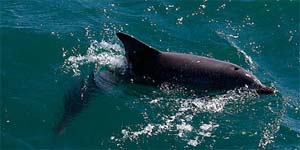Dolphins -- School-Age
Dolphins
Things to Know
Dolphins are mammals. They are warm-blooded animals. Dolphins give birth to live young, nurse their young from mammary glands, have sharp teeth, beak like snout, a sickle-shaped dorsal fin, a four-chambered heart, are warm-blooded and have some hair but very little.
Dolphins breathe air. They have lungs and breath air through the blowhole located near the top of their head. They can not breathe under water like a fish can as they do not have gills.

Dolphins breathe air at the surface of the water through a blowhole. How often they need to breathe and how long they can hold their breath depends on the species. The common Dolphin can hold its breath up 15 minutes or more, although they usually stay only a few minutes diving. The bottle nosed dolphins needs to breath every 2 minutes.
When dolphins come to the waters surface to breathe, they make a short, explosive exhalation, then take a longer inhalation before submerging again. A dolphin empty and refill its blowhole in less than a fifth of a second. Water in a dolphins blowhole will drown the dolphin, a muscular plug closes the blowhole to keep water out of the dolphins lungs when they dive.
Mammals
Dolphins are members of the cetaceans group of mammals; which includes all whales and dolphins. The cetacean order divides into two suborders. Type of teeth is used to determine which suborder the whale is; whales with teeth and whales with baleen. Dolphins have sharp teeth.
Video
Habitat
Dolphins live all over the world, from cold northern waters and warm southern waters. Dolphins internal temperature is 98 degrees fahrenheit (36 degrees celsius). To conserve their body heat in cold water the dolphin has a think layer of fat called "blubber" just below the skin. Dolphins live in groups called pods. A pod is made up of 12 or more dolphins. The male dolphin is called a bull. The female dolphin is called a cow. A baby dolphin is called a calf.
Bottlenose dolphins prefer warm waters. The bottlenose dolphin is the saltwater mammal symbol of Florida, Mississippi, and South Carolina.

Senses
A dolphin can use sound, vision, touch, and taste. A dolphin has very little sense of smell. A dolphin can make a unique signature whistle that may help individual dolphins recognize each other. Sounds of whales and dolphins.
Echolocation
A dolphin will eat mainly fish or squid depending what part of the ocean they are in. Dolphins use their sense of sight, hearing, and echolocate to find the fish and squid they need to survive. Echolocation is a way to use sound to locate objects in the environment. Bats use it in the air and dolphins use it in the water. A dolphin produces frequencies with a clicking sound. It is believed that the dolphin can hear the returning echo by feeling the sound pulses. Different objects give off different echoes.
How dolphins and porpoise use sound- The Cardigan Bay Marine Wildlife Centre.
Video
Body

The body shape of a dolphin helps it to be a fast swimmer. They are usually black, brown, or gray in color and are often marked with patterns of white or light colors. The deepest dive ever recorded for a bottlenose dolphin was a 990 feet (300 meters). It is most likely that many bottlenose dolphins do not dive very deep as many live in fairly shallow water. Dolphins can jump up to 15 to 30 feet above the water.
Sleep
Dolphins sleep with one eye open. They let one half of their brain sleep at a time. This allows them to watch for danger and know when to rise to the surface for breath. It makes it possible for the dolphin to surface to get breath, which they couldn't do if they were all the way asleep. A dolphin will sleep along the surface of the water or rise to the surface occasionally while sleeping along the bottom of a shallow area.
Video
Dolphins and Porpoises

Dolphin
Some of the differences between dolphins and porpoises.
Porpoises are smaller, they seldom exceed 7 feet in length. Whereas, dolphins can exceed 10 feet in length. Porpoises have rounder heads than dolphins. A dolphin usually will have a large forehead. Porpoises are beak-less, whereas dolphins will have a beak.

Porpoise
Bottlenose Dolphin
Spectacled Porpoise
Dall's Porpoise
There are at least 40 species of dolphins.
Recommended Book
Dolphin (I Can Read Level 3)
by Robert A. Morris
Perfect for young readers. A lovely story about the life of a pod of dolphins and the adventures of a baby dolphin.
Sites to See
Bottlenose Dolphins color page at National Geographic.
Dolphin and Humpback Whale Origami
Print and fold to create a dolphin.
Word search, crossword, and more.
Dolphin Craft
Made from a milk carton or tissue box.
Virtual Explores
Read about the expedition and research of Amazon River dolphins.
Video







